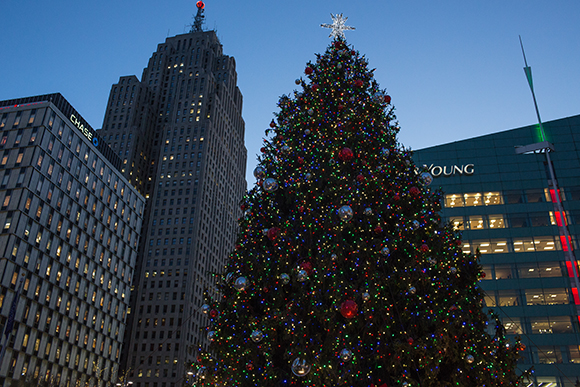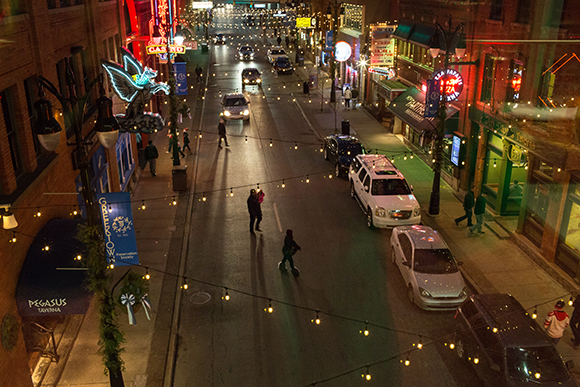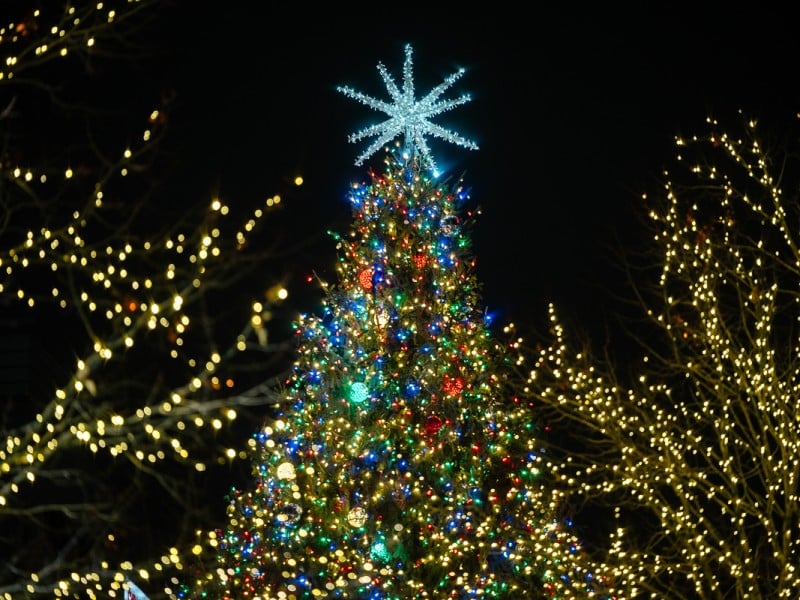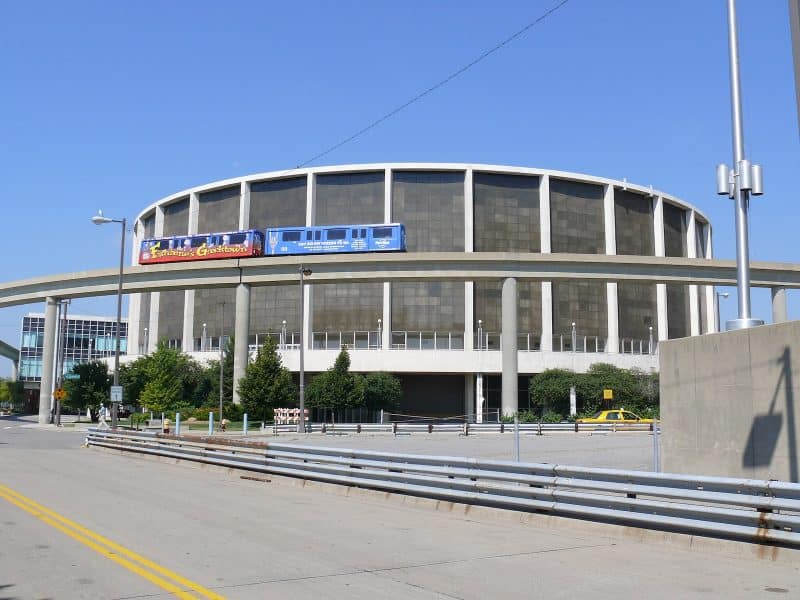Lighting up Detroit: Holiday displays, new infrastructure projects illuminating the city
As Detroit emerges from the darkness of bankruptcy, we say "let there light!" this holiday season. Here's a backstage tour of lighting in Detroit, from schools to streetlights to the Christmas tree at Campus Martius.
We’re quickly approaching the darkest time of year in Southeast Michigan. On Dec. 21, the winter solstice, the sun will shine for a mere nine hours before giving way to a night sky made all the darker by the absence of the moon.
The solstice comes this year at a particularly bleak time in Detroit, following a contentious period of bankruptcy and emergency management that’s left no shortage of unresolved issues. Despite these challenges, however, there are glimmers of light.
For one, the downtown is awakening to its seasonal bloom of holiday colors. Campus Martius blazed into its full winter splendor on Nov. 21 during the city’s annual Christmas tree lighting ceremony. The 60-foot Norway spruce towering over the park is draped with more than 19,000 multi-colored LED lights as well as red and silver ornaments. Not far away, a 24-foot-tall Salvation Army kettle, the world’s largest, casts a rosy red glow on Cadillac Square. To top it off, Jefferson, Woodward, and other nearby locales have been decorated with about 350,000 lights to accentuate the holiday spirit downtown.
Inspiring as these holiday hues may be, they aren’t the only lights coming on in Detroit this season. There are also efforts afoot to illuminate streets darkened by a dysfunctional streetlight network and mend a failing electrical grid.
Until recently, taking care of this infrastructure has been the jurisdiction of the city’s Public Lighting Department. The PLD, however, has done a poor job of maintaining these systems, due in no small part to long-term financial issues caused by Detroit’s shrinking population and eroding tax base.
Engineering studies have found more than half of the city’s 88,000 streetlights were out of commission last year, due to burned out bulbs, deteriorated infrastructure, and copper theft. Detroit’s power grid has experienced frequent outages in recent years, most recently on Dec. 2. That outage left streetlights and hundreds of public buildings without power for hours.
Politicians have responded to these issues by creating a new lighting authority to overhaul, maintain, and manage Detroit’s streetlights and by transferring PLD’s electrical responsibilities to the DTE Energy Company. Both undertakings offer a glimmer of hope for citizens who have all too often been left in the dark.
Lights on the Streets
Detroit’s new Public Lighting Authority (PLA) has had a stellar year, installing around 30,000 new streetlights around the city in less than 11 months.
Odis Jones, the PLA’s CEO, says the agency has finished about 65 percent of its installation work in residential neighborhoods. In fact, the authority completed all of its planned 2014 installations back in September, about 15 percent ahead of projections.
“We’re way ahead,” says Jones. “I’m excited, but I’m also cautiously optimistic because the work gets tougher as we move ahead.”
Working through the winter, his agency is now starting to tackle more complicated work with underground conversions.
Before coming to the PLA, Jones, a Detroit native, had been an economic development director in Cincinnati. He says that he is humbled to play a part in rebuilding his hometown’s infrastructure.
“It really impacts people’s sense of safety,” he says. “It’s beyond just light. It’s about a sense of community, a sense of place, a sense of purpose.”
The agency has prioritized relighting residential areas first before moving on to collector streets, which collect traffic traveling to busier main roads and larger thoroughfares.
The new lamps are an upgrade too. The 150-watt equivalent LED lights coming to the neighborhoods are twice as bright as the former high pressure sodium bulbs. On main thoroughfares like Gratiot and Grand River, 400-watt equivalent lights will be replacing 250-watt models. The new lamps are more energy efficient too, which will help save money in the long run.
All this work started with a state law that was passed in December 2012 authorizing lighting authorities. The PLA’s articles of incorporation were approved by Detroit City Council in February 2013. A five-member board of Detroit residents appointed by the mayor and city council oversees the agency. It’s funded by earmarking $12.5 million a year from the city’s utility tax, and its work is supplemented by the sales of bonds.
As for who does this work, it’s a public-private partnership, meaning that the agency outsources with private-sector firms. DTE Energy now serves as an owner’s advisor, helping out with engineering and planning. Construction and maintenance is handled by an assortment of contractors who work through the IBEW union. Eighty percent of these construction firms are headquartered in Detroit, and 35 percent of their workforce lives in the city.
The PLA currently manages residential streetlights in 25 of Detroit’s 29 ZIP codes, and is slowly taking over control of the system from the Public Lighting Department. It plans to have all the city neighborhoods done by next year and wrap up work on collector streets and thoroughfares by 2016. After that Jones says the PLA’s mission is clear.
“Once we build it, our job is to maintain it to ensure we never get in this rut again,” he says.
Restoring the Grid
While the PLA has been taking over streetlights, DTE Energy has been assuming control of the city-owned electrical grid during the phasing out of the Public Lighting Department.
The utility company took over operations in July and is now using the formerly city-owned wires to service approximately 115 different customers. To break this down further, it is now overseeing Detroit’s streetlight system and around 900 different structures, including city and county buildings, fire and police stations, schools, and entertainment venues like Joe Louis Arena.
To put this a different way, DTE is effectively leasing out the old city lines as it updates the system as part of a multi-year, $200 million dollar overhaul.
So far, according to Ron May, DTE’s Executive Vice President for Major Enterprise Projects, the company has transitioned about 190 different elements, including five schools, since the middle of July, to a new more modern grid. By the end of 2014, DTE plans to have 202 of the 978 Automatic Traffic Signals (red-yellow-green signals) transitioned to the DTE system, leaving 776 to be done. Also by the end of 2014, DTE plans to have 7 schools and 2 fire stations converted with approximately 1400 meters remaining.
“The level of service has gone way up in terms of that the outages are shorter, and it’s a remarkable difference in terms of what many of the customers are seeing,” he says.
It’s made a big difference to schools in particular, May adds, noting there weren’t any school outages on counting day or election day this year.
DTE is also building two new substations, one at Stone Pool Park in Midtown near the John C. Lodge Expressway and another by the Masonic Temple. That’s being done to enhance service to schools, downtown traffic signals, and the new Red Wings stadium.
May says customers can expect things to be completely converted in about five or six years’ time, adding that service will improve noticeably for customers as the project moves along.
“As load reduces and circuits get shorter and stations get retired year after year after year,” he says, “that [remaining infrastructure] has a little more attention and it’s a little less loaded, so it automatically has better service. That will be what’s coming.”













